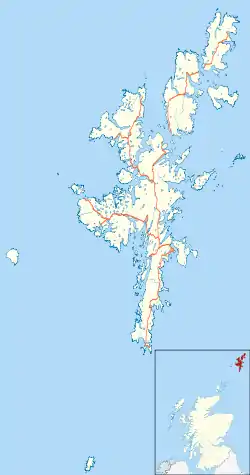Lerwick Town Hall
Lerwick Town Hall is a municipal building located in central Lerwick, Shetland, Scotland. The town hall, which is the headquarters of Shetland Islands Council, is a Category A listed building.[1]
| Lerwick Town Hall | |
|---|---|
 Lerwick Town Hall | |
| Location | Lerwick |
| Coordinates | 60°9′16″N 1°8′46″W |
| Built | 1883 |
| Architect | Alexander Ross |
| Architectural style(s) | Scottish Baronial style |
Listed Building – Category A | |
| Designated | 8 November 1974 |
| Reference no. | 37256 |
 Shown in Shetland | |
History
For much of the 19th century meetings of the local council were held in the Parish Kirk in Queens Lane.[2] After a period of rapid population expansion in Lerwick associated with the growth in the herring industry, civic leaders decided to procure a purpose-built town hall: a site on the north Hillhead was selected.[2]
The foundation stone for the new building was laid by Prince Alfred, Duke of Edinburgh on a visit to the isles on 24 January 1882.[2] That same evening Lerwick saw the first ever Up Helly Aa torchlight procession.[2] The new building was designed by architect, Alexander Ross from Inverness, in the Scottish Baronial style and builder John M. Aitken of Lerwick won the tender competition with a price of £3,240.[2] The building was officially opened by George Thoms, Sheriff of Caithness, Orkney and Shetland, on 30 July 1883.[2] The design involved a symmetrical frontage with five bays facing on Hillhead; the central section featured an arched doorway on the ground floor; there was an oriel window on the first floor with a pediment bearing a coat of arms above and there were bartizans at the corners of the building.[1] There was a battlemented tower on the east side and a rose window on the north side.[1] Internally, the principal rooms were a council chamber and a courtroom; there were also police cells in the building.[2]
Stained glass windows, designed by James Ballantine & Son, were subsequently installed in the building: these included a depiction of the marriage between Margaret of Denmark and James III of Scotland in 1469.[3] There were also windows presented by the Corporation of Amsterdam and the Corporation of Hamburg.[4] Panels with the coats of arms of Aberdeen, Edinburgh, Glasgow and Leith, which had been presented by the respective corporations, were installed in a corridor.[5] A clock, designed and manufactured by Potts of Leeds, was installed in the tower in 1887.[6]
The town hall was the headquarters of Lerwick Town Council until 1975 and has been the home of the Shetland Islands Council since then.[7] The front steps, which had badly decayed, were replaced in spring 2008.[2]
Works of art in the town hall include a portrait of Queen Elizabeth II by Leonard Boden[8] and a portrait of Charles Rampini, Sheriff of Dumfries and Galloway,[9] by John Henry Lorimer.[10]
Services
The town hall is used for functions such as marriages, wedding receptions, concerts, coffee mornings and evening events.[11]
References
- Historic Environment Scotland. "Lerwick Town hall, Hillhead and Charlotte Street, Including Lamp Standards, Gatepiers, Boundary Walls and Railings, Lerwick (Category A Listed Building) (LB37256)". Retrieved 14 April 2020.
- "It cost £4,940 15/6d to build, now monument to civic splendour is 125 years old". The Shetland Times. Retrieved 14 April 2020.
- "Lerwick's Fine Victorian Town Hall Is Reborn". Shetland Islands Council. Retrieved 14 April 2020.
- "Hamburg Window". Shetland Islands Council. Retrieved 14 April 2020.
- "Lerwick". Vision of Britain. Retrieved 14 April 2020.
- Potts, Michael (2006). Potts of Leeds – Five Generations of Clockmakers. Mayfield Books. p. 395. ISBN 0-9523270-8-2.
- "Shetland: a model for the future". The Shetland Times. 5 April 2013. Retrieved 14 April 2020.
- Boden, Leonard. "HM Queen Elizabeth II (b.1926)". Art UK. Retrieved 14 April 2020.
- "No. 27196". The London Gazette. 25 May 1900. p. 3333.
- Lorimer, John Henry. "Charles Rampini (1840–1907)". Art UK. Retrieved 14 April 2020.
- "Welcome to Shetland Islands Council". shetland.gov.uk. Archived from the original on 13 August 2006. Retrieved 20 January 2014.
